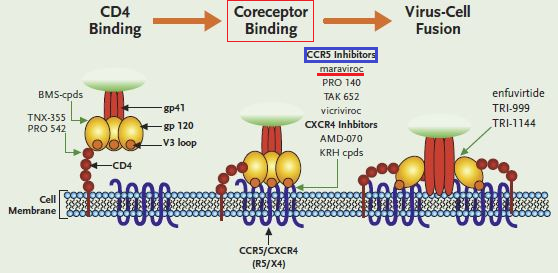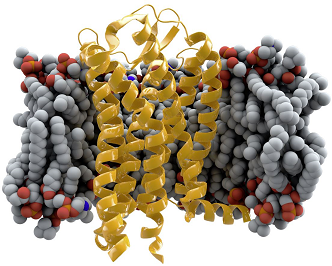|
|
|
Medical Pharmacology Chapter 36: Antiviral Drugs
Viral-Cell Membrane Fusion (continued): The association of viral surface protein receptors often causes a conformational change which promotes virus in cell fusion along with formation of a pore that enables viral nucleocapsid delivery into the cell cytoplasm.1
![]() The drug enfuvirtide, derived
from gp41, binds to gp41 in a way that prevents the structural change needed
for fusion (see previous page).
The drug enfuvirtide, derived
from gp41, binds to gp41 in a way that prevents the structural change needed
for fusion (see previous page).
Another drug, maraviroc, inhibits viral entry by binding to one of the chemokine HIV co-receptors, CCR5, thus inhibiting interaction with gp120 and inhibiting fusion initiation.1
|
|
|
In 2007 the US FDA approved the first member of a new group of antiretroviral drugs used for treating HIV-1 infection.2
This agent, Maraviroc (Selzentry, Celsentri) acts by interfering with the interaction between HIV-1 gp120 protein and the chemokine co-receptor CCR5.
Maraviroc was FDA approved for use in those patients experiencing virologic failure secondary to resistance to other antiviral medications.2
 |
|
Studies about 30 years ago identified the CD4 receptor as the principal target for HIV-1 binding to CD4+ cells.
Experiments using hybrid mouse cells expressing human CD4+ indicated that CD4+ binding by itself is insufficient to cause viral entry.
Subsequently, two co-receptors were discovered.
These co-receptors were CCR5 (C-C chemokine Receptor type 5)and CXCR4 and were chemokine receptors which were also necessary for viral entry, along with the CD4+ receptor.
CCR5 is associated with naturally occurring ligands:
Such as macrophage inflammatory protein (MIP) 1α and 1β i.e. MIP1α and MIP1β (also known as CCL3 and CCL4) and
RANTES, which is a chemotactic protein also known as CCL5.
 |
|
|
|
|
|
|
|
|
These HIV-1 co-receptors, CXCR4 and CCR5, are part of the G protein-coupled receptor superfamily described in earlier sections.6
These G proteins systems have been identified as important pharmacological therapeutic targets in a variety of diseases.
CCR5 is considered an especially important therapeutic target since genetic absence of surface expression of this protein confers nearly complete resistance to HIV-1 infection.7
|
|
|
|
|
|
|
This Web-based pharmacology and disease-based integrated teaching site is based on reference materials, that are believed reliable and consistent with standards accepted at the time of development. Possibility of human error and on-going research and development in medical sciences do not allow assurance that the information contained herein is in every respect accurate or complete. Users should confirm the information contained herein with other sources. This site should only be considered as a teaching aid for undergraduate and graduate biomedical education and is intended only as a teaching site. Information contained here should not be used for patient management and should not be used as a substitute for consultation with practicing medical professionals. Users of this website should check the product information sheet included in the package of any drug they plan to administer to be certain that the information contained in this site is accurate and that changes have not been made in the recommended dose or in the contraindications for administration. Advertisements that appear on this site are not reviewed for content accuracy and it is the responsibility of users of this website to make individual assessments concerning this information. Medical or other information thus obtained should not be used as a substitute for consultation with practicing medical or scientific or other professionals. |